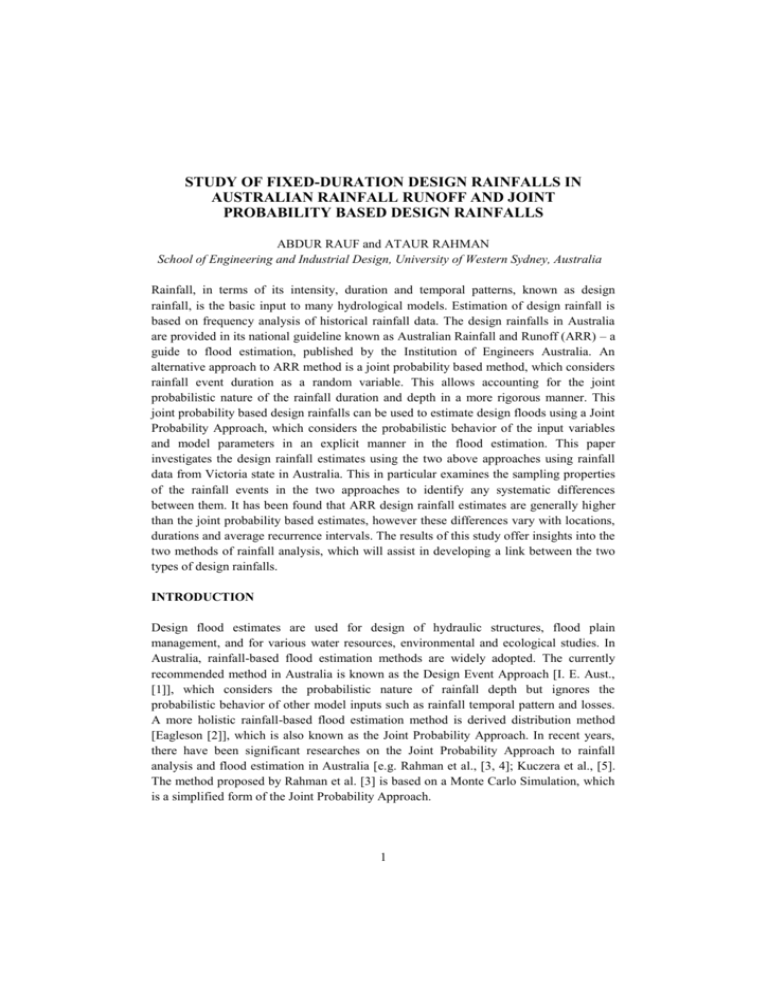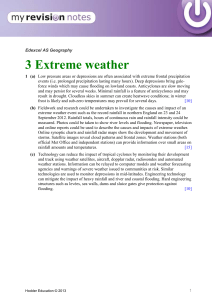56-OHS-A237_Rauf_Rahman
advertisement

STUDY OF FIXED-DURATION DESIGN RAINFALLS IN AUSTRALIAN RAINFALL RUNOFF AND JOINT PROBABILITY BASED DESIGN RAINFALLS ABDUR RAUF and ATAUR RAHMAN School of Engineering and Industrial Design, University of Western Sydney, Australia Rainfall, in terms of its intensity, duration and temporal patterns, known as design rainfall, is the basic input to many hydrological models. Estimation of design rainfall is based on frequency analysis of historical rainfall data. The design rainfalls in Australia are provided in its national guideline known as Australian Rainfall and Runoff (ARR) – a guide to flood estimation, published by the Institution of Engineers Australia. An alternative approach to ARR method is a joint probability based method, which considers rainfall event duration as a random variable. This allows accounting for the joint probabilistic nature of the rainfall duration and depth in a more rigorous manner. This joint probability based design rainfalls can be used to estimate design floods using a Joint Probability Approach, which considers the probabilistic behavior of the input variables and model parameters in an explicit manner in the flood estimation. This paper investigates the design rainfall estimates using the two above approaches using rainfall data from Victoria state in Australia. This in particular examines the sampling properties of the rainfall events in the two approaches to identify any systematic differences between them. It has been found that ARR design rainfall estimates are generally higher than the joint probability based estimates, however these differences vary with locations, durations and average recurrence intervals. The results of this study offer insights into the two methods of rainfall analysis, which will assist in developing a link between the two types of design rainfalls. INTRODUCTION Design flood estimates are used for design of hydraulic structures, flood plain management, and for various water resources, environmental and ecological studies. In Australia, rainfall-based flood estimation methods are widely adopted. The currently recommended method in Australia is known as the Design Event Approach [I. E. Aust., [1]], which considers the probabilistic nature of rainfall depth but ignores the probabilistic behavior of other model inputs such as rainfall temporal pattern and losses. A more holistic rainfall-based flood estimation method is derived distribution method [Eagleson [2]], which is also known as the Joint Probability Approach. In recent years, there have been significant researches on the Joint Probability Approach to rainfall analysis and flood estimation in Australia [e.g. Rahman et al., [3, 4]; Kuczera et al., [5]. The method proposed by Rahman et al. [3] is based on a Monte Carlo Simulation, which is a simplified form of the Joint Probability Approach. 1 2 Application of the Joint Probability Approach ideally requires periods of long continuous rainfall data to derive marginal distributions of various rainfall characteristics such as duration, average rainfall depth (intensity) and temporal pattern. Design rainfalls are rainfall intensities, generally expressed in the form of intensity-frequency-duration (IFD) curves and used as the basic input to many flood estimation models. Design rainfall data in the form of IFD curves, based on the concept of Design Event Approach, are available in Australian Rainfall and Runoff (ARR), which is the national guideline for design flood estimation in Australia [1]. The design rainfall data in the Joint Probability Approach are different to that of ARR because of different sampling properties of rainfall events. The ARR method considers prefixed durations while the Joint Probability Approach considers rainfall duration as a random variable. The objective of this paper is to identify the relationship between ARR IFD and Joint Probability IFD data. Any meaningful relationship between these two design rainfall intensities will allow derivation of JP IFD data from ARR IFD data thus overcoming the current difficulty in the direct derivation of Joint Probability IFD data, which generally requires a longer period of pluviograph data. OVERVIEW OF DESIGN RAINFALLS IN AUSTRALIA The ARR IFD data were obtained in mid eighties based on a large number of pluviograph stations distributed all over Australia. For an individual station, annual maximum series of rainfall intensity for various durations (for example, 1, 6, 24, 48 and 72 hours) were extracted and a Log Pearson Type 3 distribution was fitted to the annual series. The design rainfall intensities of various average recurrence intervals (ARI) (for example, 1, 2, 5, 10, 20, 50 and 100 years) were computed from the fitted Log Pearson Type 3 distribution. Finally, the annual maximum series estimates were adjusted to obtain partial duration series estimates. In the Monte Carlo Simulation Technique, to provide the basis for a rigorous assessment of flood probabilities, a new storm event definition is required that produces rainfall events of random durations. Two different storm event definitions can be used: a ‘complete storm’ and a ‘storm-core’ within each complete storm (the most intense part of the storm). A complete storm is defined as a period of significant rain preceded and followed by an arbitrarily defined period of dry hours (e.g. 6 hours). The corresponding storm-core is selected as the period within a complete storm that has the highest rainfall intensity ratio compared to the 2-year ARI ARR design rainfall intensity. The method of Rahman et al. [3] allows selection of 4 to 7 most significant partial duration series rainfall storm-core events on average per year. The selected storm-core events are then analysed to develop Joint Probability IFD curves using the following method. The range of storm-core durations (Dc) are divided into a number of class intervals (with a representative duration being selected for each class except the 1h class), e.g. 2-3h (representative duration 2h), 4-12h (6h), 13-36h (24h). 3 For the data in each class interval (except the 1h), a linear regression line is fitted between log(Dc) and log(Ic). Here Ic is the average rainfall intensity of storm-core. The slope of the fitted regression line is used to adjust the intensities for all durations within the interval to the representative duration. An exponential distribution is fitted to the partial series of the adjusted intensities within the class interval, and design intensity values Ic(ARI) are computed for ARIs of 2, 5, 10, 20, 50 and 100 years. For a selected ARI, the computed Ic(ARI) values for each duration range are used to fit a second-degree polynomial between log(Dc) and log(Ic). For the stations analyzed in this study and for all the selected ARIs, the observed R2 values were found to be greater than 98%. These polynomials can be used to obtain for each selected ARI a value of rainfall intensity Ic for a duration Dc (1h Dc 100h). STUDY AREA AND DATA The selected study area is the Victorian state of Australia. Victoria occupies the southeast corner of the continent between latitudes 34 and 39 south and longitudes 141 and 150 east. It covers an area of 227,600 km2. From the database of pluviograph stations in Victoria, a total of 91stations having longest periods of good quality data were selected for the study. The locations of the selected stations are shown in Figure 1. Figure 1. The Study Area – Victoria State in Australia and selected pluviograph stations locations RESULTS Selection of storm events The ARR method uses prefixed durations and allows selection of same rainfall spells for various durations in the formation of annual maximum series. For example, a rainfall spell of 3-hour duration can be included as a part in the 12-hour duration. This makes various data points across various durations less independent. To examine how frequently the same rainfall spell can be repeated in the data series across various durations, a term ‘commonality’ is used here. The ‘commonality’ of storm event of a standard duration is used to measure the frequency of repetition of the storm event of that duration in the storm events of subsequent longer durations. Standard durations used here are 1, 2, 3, 6, 12, 24 and 48 hours. The ‘commonality’ can be better explained using Table 1, which uses an asterisk (*) to indicate common rainfall spell in two durations. For Station 82042, 4 there is a common spell of rainfall for the storm durations of 1- and 2-hour, similarly for 3- and 6-hour storms. Table 1. Storm duration commonality matrix for Stations 82042 and 84005 Storm duration (hours) 82042 Strathbogie PO (Year 1996) 1 1 2 3 6 12 24 48 84005 Buchan PO (Year 1964) 72 * 1 2 3 6 12 24 * * * * * 2 * * * 3 * * * * * 1 2 3 * 6 6 12 * 24 * * 12 * * 24 48 48 72 * 48 Percentage commonality of storm events for a station can be calculated by dividing the number of repetitions (i.e. the number of asterisk) occurred divided by the maximum possible number of repetitions over the available periods of record. The maximum possible number of repetition among storms of different standard durations is 28 in any year, as shown by shaded cells in Table 1. For Station 82042, the percentage commonality is 7/28 = 25% for the year 1996. For the 91 pluviograph stations, percentage commonality values range from 33 to 67%, with an average value of 51%. The distribution of parentage commonality values for the 91 stations is presented in Figure 2. Some 65% of the pluviograph stations show 45 to 60 percent commonality value. This commonality indicates that same rainfall spells are shared by many events. This Distribution of percentage dependency No of Occurence 35 30 25 20 15 10 5 0 30-35 35-40 40-45 45-50 50-55 55-60 60-65 65-70 Dependency class (%) Figure 2. Distribution of percentage commonality values in Victoria is not the case for the Joint Probability Approach in that a rainfall spell can be included 5 only once in the data series for constructing IFD curves. This makes rainfall intensity data points in the partial duration series in the Joint Probability Approach more independent. Relationship between ARR IFD and JP IFD curves IFD curves by the ARR method for durations 1, 2, 6, 24, 48 and 72 hours and ARIs of 1, 2, 5, 10, 20, 50 and 100 years were developed for 88 of the selected pluviograph stations using a computer program developed for this study. Figure 3 shows a typical ARR IFD curves. IFD Curves in ARR Method Station: 79079 Tottington Rainfall Intensity mm/hr 100 100 Yr 50 Yr 20 Yr 10 Yr 5 Yr 2 Yr 1 Yr 10 1 1 hr 2 hr 3 hr 6 hr 12 hr 24 hr 48 hr 72 hr Duration (hr) Figure 3. IFD curves by ARR method for the Station Tottington (79079) A FORTRAN programme was developed to generate Joint Probability IFD curves as per the method described before. Figure 4 presents a typical IFD curve in the Joint Probability Approach. Results from the 88 stations in the study area indicated a high degree of consistency in the derived Joint Probability IFD curves. IFD Curves in Joint Probability Approach Station: 79079 Tottington Rainfall Intensity mm/hr 100 100 Yr 50 Yr 20 Yr 10 Yr 5 Yr 2 Yr 1 Yr 10 1 1hr 2hr 6hr 24hr 48hr 72hr 100hr Duration (hr) Figure 4. IFD curves by Joint Probability approach for the Station Tottington (79079) 6 Relationship between ARR and JPA IFD Curves A key issue for the practical application of the Joint Probability approach to design flood estimation is whether the IFD curves of this method and ARR are related. Any meaningful relationship between these two types of IFD curves can be used to estimate Intensity-Frequency-Duration Curve - 100 Yr ARI Station: 86142 Mt St Leonard 100 Joint Probability Rainfall Intensity (mm/h) ARR 10 1 1 10 100 Duration (h) Figure 5. Comparison plots of ARR IFD and JP IFD for 100 years ARI of the Station Mt St Leonard (86142) Intensity-Frequency-Duration Curve - 100 Yr ARI Station: 85237 Noojee Eng. HMSD Rainfall Intensity (mm/h) 100 ARR Joint Probability 10 1 1 10 100 Duration (h) Intensity-Frequency-Duration Curve - 2 Yr ARI Station: 85237 Noojee Eng. HMSD 100 ARR Joint Probability 10 1 0.1 1 10 100 Duration (h) Figure 6. Comparison plots of ARR IFD and JP IFD curves for the station Noojee Eng. HMSD for ARI 100 and 2 years 7 Joint Probability IFD curves from readily available ARR IFD curves. To examine the relationship between the two types of IFD curves, comparison plots were constructed for durations of 1, 2, 3, 6, 12, 24, 48, 72 hours and ARIs of 1, 2, 5, 10, 20, 50, 100 years for 20 pluviograph stations. Examination of these plots revealed a fairly regular relationship between the Joint Probability and ARR IFD curves. The ARR estimates of design rainfall intensities are generally slightly higher than that of the Joint Probability approach. This is as expected because Joint Probability rainfall events are more independent as mentioned before. However there were a few exceptions where ARR IFD values were little higher, these were mainly limited to stations with short period of data. IFD Curve -100 Yr ARI IFD Curve - 5 Yr ARI Station: 89016 Lake Bolac Station: 89016 Lake Bolac PO Rainfall Intensity (mm/h) 100 100 ARR Joint Probability ARR Joint Probability 10 10 1 1 1 10 Duration (h) 100 0.1 1 10 100 Duration (h) Figure 7. Comparison plots of ARR IFD and Joint Probability IFD curves for the station Lake Bolac PO for ARI 100 and 5 years Three remarkable trends in the relationships of ARR IFD and Joint Probability IFD curves were noted. Firstly, the ARR IFD curve is higher than the Joint Probability IFD curve for the short storm durations and the difference diminishes with the increase in duration and decrease in ARI, as shown in Figure 5. This trend was generally noticed when the percentage commonality value of rainfall spells across different durations was around 50%. Secondly, both the IFD curves are very similar, with ARR IFD curve slightly higher than Joint Probability IFD curve for higher ARIs, as shown in Figure 6. This trend was generally noticed when the percentage commonality value of rainfall spells across different durations was around 64%. Lastly, both the IFD curves are very close at the shorter storm durations but the Joint Probability IFD curve is smaller than ARR IFD curve with the increase in storm duration and decrease in ARI, as illustrated in Figure 7. This trend was generally noticed when the percentage commonality value of rainfall spells across different durations was smaller than 50%. CONCLUSIONS This paper examines the sampling properties of rainfall events for constructing intensityfrequency-duration (IFD) curves in the Australian Rainfall and Runoff method and Joint Probability Approach. Following conclusions can be made from this study. The method of selecting storm burst events in Australian Rainfall and Runoff allows repetition of same rainfall spell in different durations, which implies that many data 8 points across various durations are not independent. For 91 stations in Victoria, it was found that about 50% storm burst events share common rainfall spells in Australian Rainfall Runoff Method. In general, the Australian Rainfall Runoff IFD curves are higher than that of the Joint Probability approach. A relationship between Australian Rainfall Runoff and Joint Probability IFD curves exists as a function of storm durations, average recurrence intervals and locations. Further analysis is required to identify the precise nature of this relationship. ACKNOWLEDGEMENT The authors would like to thank Bureau of Meteorology, Australia for supplying the pluviograph data for the study, Mr Faruk Kader for his assistance in data collation. and the Cooperative Research Centre for Catchment Hydrology, Monash University, Australia, where the Second Author (Dr Rahman) developed the FORTRAN programs used in this analysis. REFERENCES [1] I. E. Aust. Australian Rainfall and Runoff – A guide to flood estimation. Institution of Engineers Australia, (1997) [2] Eagleson, P. S. Dynamics of flood frequency. Water Resources Research, 8, 4, (1972), 878-898. [3] Rahman, A., Weinmann, P. E., Hoang, T.M.T, Laurenson, E. M. Monte Carlo Simulation of flood frequency curves from rainfall. Journal of Hydrology, 256 (3-4), (2002), 196-210. [4] Rahman, A., Weinmann, P. E. and Mein, R.G. The use of probability-distributed initial losses in design flood estimation. Australian Journal of Water Resources. 6(1), (2002), 17-30. [5] Kuczera, G., Lambert, M., Heneker, T., Jennings, S., Frost, A. and Coombes, P. 2003. Joint Probability and Design Storms at the Crossroads. Keynote paper. 28th International Hydrology and Water Resources Symposium, I. E. Aust, 11 – 13 Nov, Wollongong, Australia, (2003).







